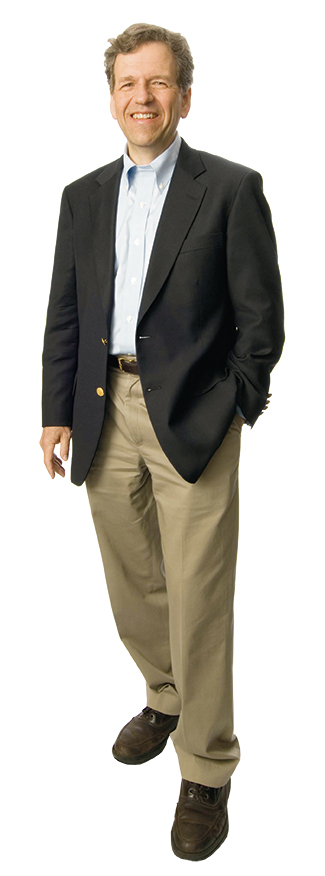Engineering Dean Matt O’Donnell takes a direct approach
 The new dean of the UW College of Engineering doesn’t have an engineering degree. But that’s not the only surprising aspect of Matt O’Donnell, who was chair of biomedical engineering at the University of Michigan before coming to the UW last September. Trained as a physicist at Notre Dame, O’Donnell’s post-doc in bioengineering started a career in ultrasound that includes more than 50 patents and 10 years at General Electric. Another surprise: the New York native isn’t afraid of breaking through academic doublespeak with some East Coast straight-talk; he even has a chart that translates polite phrases (“Let me share my feelings about your plan”) into what they really mean (“Your plan stinks”).
The new dean of the UW College of Engineering doesn’t have an engineering degree. But that’s not the only surprising aspect of Matt O’Donnell, who was chair of biomedical engineering at the University of Michigan before coming to the UW last September. Trained as a physicist at Notre Dame, O’Donnell’s post-doc in bioengineering started a career in ultrasound that includes more than 50 patents and 10 years at General Electric. Another surprise: the New York native isn’t afraid of breaking through academic doublespeak with some East Coast straight-talk; he even has a chart that translates polite phrases (“Let me share my feelings about your plan”) into what they really mean (“Your plan stinks”).
During your 16 years at the University of Michigan, you must have gotten other job offers. Why did you turn those down and then accept the offer to come to the UW?
It’s true I got other offers. What appealed to me is that the UW looks a lot different than Michigan. Michigan is a top-tier engineering school. UW is very good, but it is not a top-tier school yet. But it has the potential to be truly world class. It’s like the difference between GM and a startup. At GM, what they do is very good, but the style is traditional. At the UW we have a different environment. For example, if you look at our top-two sources of research funding in engineering, number one is the National Science Foundation, no surprise there, but number two is the National Institutes of Health. That’s very different from what you’d find at other engineering schools. One of our largest departments is computer science and engineering. That’s also different. At most schools it would be mechanical or electrical engineering. I also liked the fact that the UW is a complete university with a medical school and a business school, etc. There is also a very attractive local tech environment.
You said the UW is not yet one of the premier engineering schools in the country. What’s holding us back?
There’s some history here. In the past, we were more of a regional engineering school with an exclusive emphasis on teaching. The research side has grown enormously in only the last 10 to 15 years. And there are still some cultural issues. For example, some departments have a strong entrepreneurial culture, but others don’t. Then there is the size of the college. We have only about 200 faculty but the top schools have 300 faculty—so we’re about two-thirds of the size we ought to be.
What’s wrong with our size?
It’s nowhere near sufficient to serve the high-tech community in the state of Washington. … And we have to reach out to more women and underrepresented groups. We’re doing better with women—in chemical engineering and bioengineering the ratio now is about 50-50. But we have to do better in other departments.
Would you like to see more non-majors take engineering courses?
I’d love to make it a requirement. If you are offering a truly liberal education for the 21st century, how could you not have a requirement like that?
There are lots of complaints about how the U.S. is falling behind in educating engineers. According to one study from Duke University, China and India collectively graduate 12 times as many engineers as the U.S. Does that worry you?
In terms of quantity, it doesn’t bother me at all. If we lose that quality edge, then we will lose completely. We should focus on modest growth in quantity while continuously improving quality.
Why did you decide to become a physicist?
I was a Sputnik kid. I liked to read about space. I was fascinated by nuclear power.
How did you move from solid-state physics—your Ph.D. focus—into ultrasound?
I remember presenting a paper at the American Physical Society annual meeting and seven people showed up. It was obvious what I was doing was not earth-shattering. I was interested in doing something that mattered. I found a post-doc at Washington University in St. Louis that was using early ultrasound techniques related to medicine. It stimulated the heck out of me. I knew what I wanted to do for the next 20 years.
You hold 50 patents and are the author or co-author of more than 200 papers. Out of all that work, what is the discovery that will have the longest-lasting benefit to your field?
I have been a strong advocate for looking at biomedical imaging as a non-invasive sensor rather than just a camera. Imaging can be used as a biosensor to look at a patient’s characteristics, down to the molecular level, without having to actually cut into the body.
Notre Dame is coming to Husky Stadium in October 2008. Who are you going to root for?
I’m going to do what I did for 16 years at Michigan whenever Notre Dame played there. I root for the team with the ball.